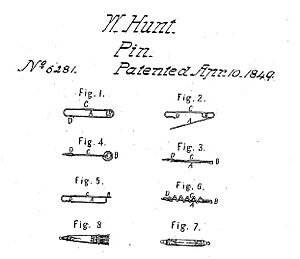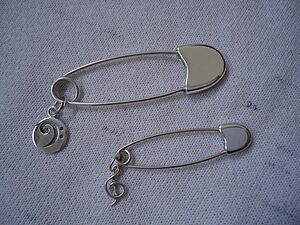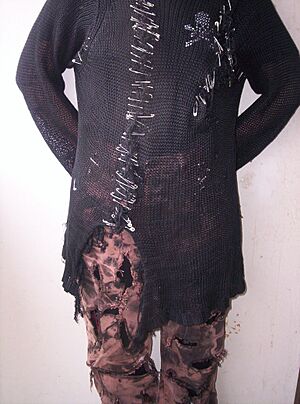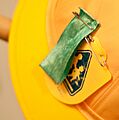Safety pin facts for kids
A safety pin is a special kind of pin that has a simple spring and a clasp. The clasp closes around the sharp point. This keeps the pin safely fastened to whatever it's holding. It also protects you from getting pricked by the sharp end.
Safety pins are often used to hold pieces of fabric or clothing together. A special type, called a nappy pin or loincloth pin, is used for cloth diapers. These pins are safer for babies because their clasp stops the baby from getting poked. Safety pins can also fix torn clothes. They are even used in jewelry like earrings or wristbands. Sometimes, they help attach an embroidered patch. Safety pins come in different sizes. Size 3 pins are often used in quilting. Larger sizes, like 4, are sometimes called "blanket pins" and can be used as kilt pins.
Contents
Early Pins: The Fibula
Long ago, people used something similar to a safety pin called a fibula. This was a type of brooch. The Mycenaeans in ancient Greece invented the fibula between 1400 and 1200 BC. People used fibulae to hold their clothes, like tunics, in place. This makes the fibula an early version of today's safety pin.
Who Invented the Safety Pin?
The modern safety pin was invented by an American mechanic named Walter Hunt. His safety pin had a clasp that covered the point. It also had a round twist in the wire that worked like a spring. This spring kept the pin closed. Another person, Charles Rowley from England, also patented a similar pin in 1849.
Hunt invented the safety pin to pay off a small debt of $15. He used a piece of brass wire about 8 inches (20 cm) long. He made a coil in the middle of the wire so it would spring open. The clasp at one end was designed to protect the user from the sharp point.
On April 10, 1849, Hunt received U.S. patent #6,281 for his invention. He then sold the patent to W.R. Grace and Company for $400. This money was worth about $15,000 in today's money. Hunt used $15 to pay his friend and kept the rest. W.R. Grace and Company later made millions of dollars from his invention.
How a Locking Safety Pin Works
A locking safety pin has a sharp pin attached to a coiled wire. This pin connects to a cap that is hooked at the end of the wire. When you push the pin into the cap's opening, it locks securely. This keeps the pin closed and safe.
Safety Pins and Health
Sometimes, young children would accidentally swallow open safety pins. This was very dangerous because the pins could get stuck in their throats. A doctor named Dr. Chevalier Jackson created special tools to safely remove swallowed safety pins. He called them "danger pins" because of the risk they posed. Even today, swallowing safety pins can be a problem in some places.
Safety Pins in Culture
In the late 1970s, safety pins became a symbol of punk rock. People who followed punk fashion started wearing safety pins on their clothes. They used them as decoration or even as piercings. This changed the safety pin from a useful tool to a fashion statement. Because of this, the safety pin is now often linked with punk rock in movies and popular culture.
More recently, in 2016, wearing safety pins on clothing became a sign of support. People wore them to show they stood with victims of unkind words and actions. This happened after the Brexit vote in the United Kingdom and later after a presidential election in the United States. Some people thought wearing a pin was not enough to help. Others believed it was a good start when combined with other actions.
Traditions and Good Luck
Safety pins are important in some cultures and traditions. In India, families often pass down pins through generations to their daughters. In Ukraine, people attach pins to children's clothes to keep away bad spirits. In other countries, a safety pin is seen as a sign of good luck.
See also
- Drawing pin
- Infant clothing
- Fibulae and ancient brooches
- Black Versace dress of Elizabeth Hurley (a famous dress held together by safety pins)
- Paper clip
- Tie pin
Images for kids






